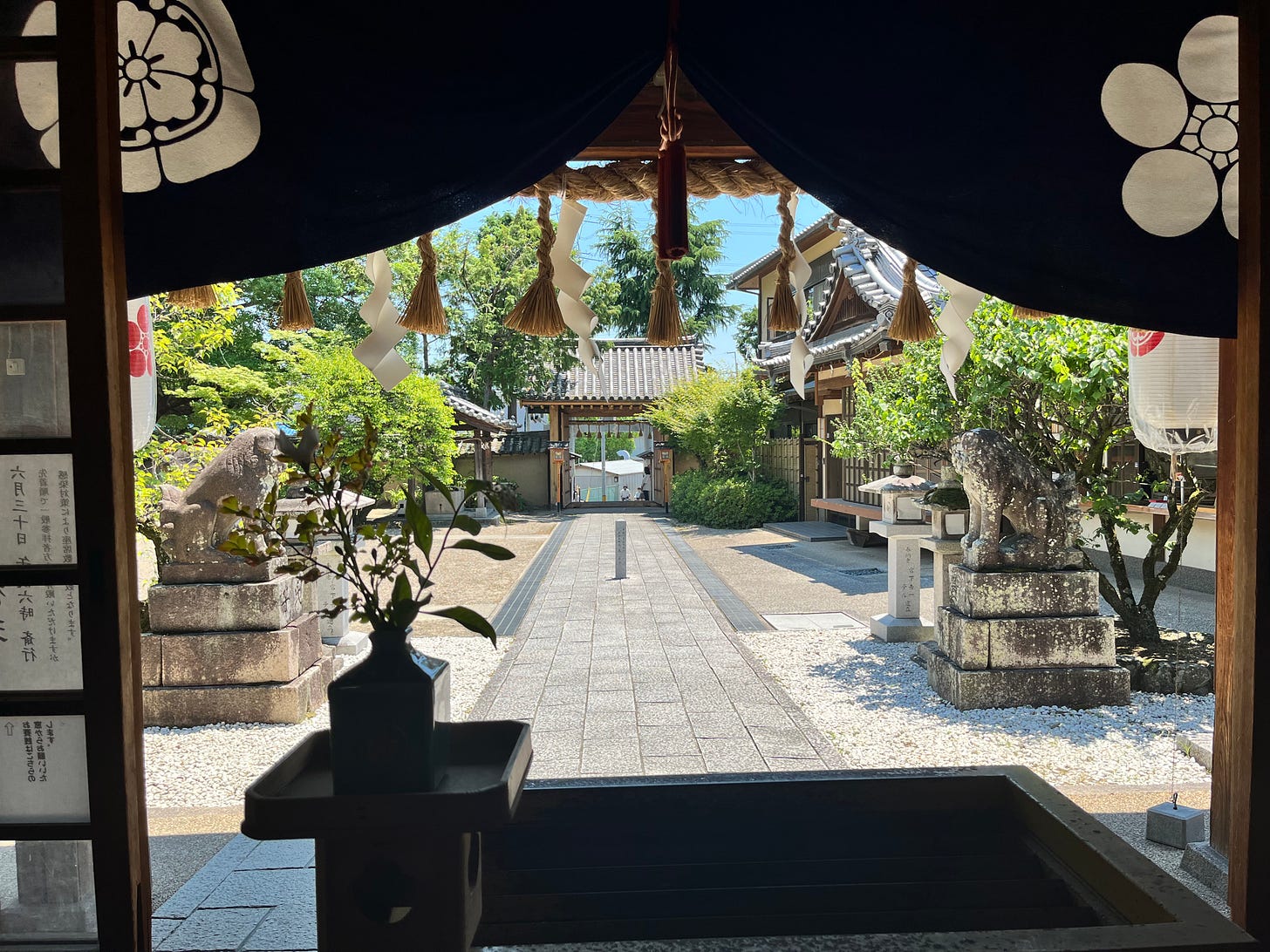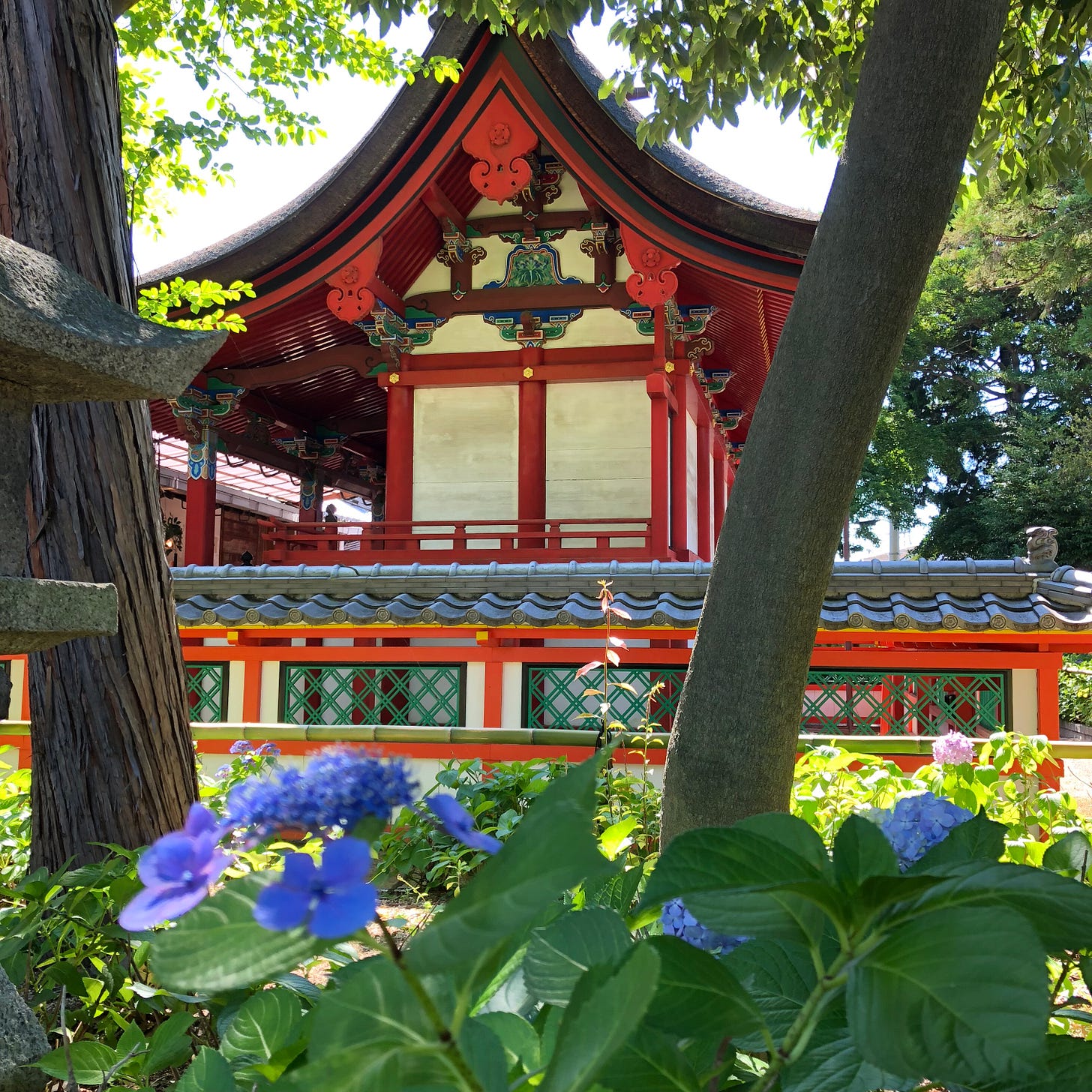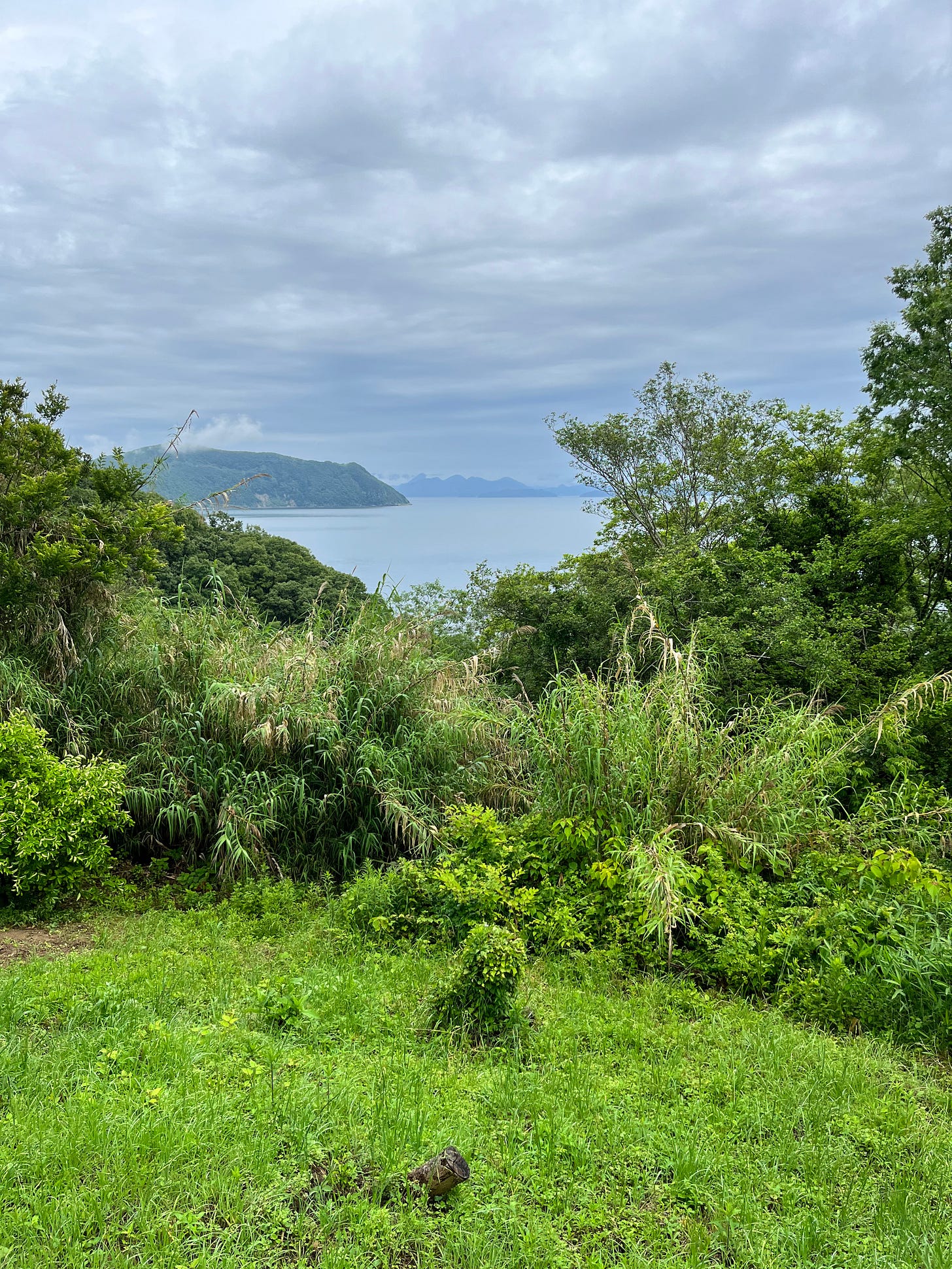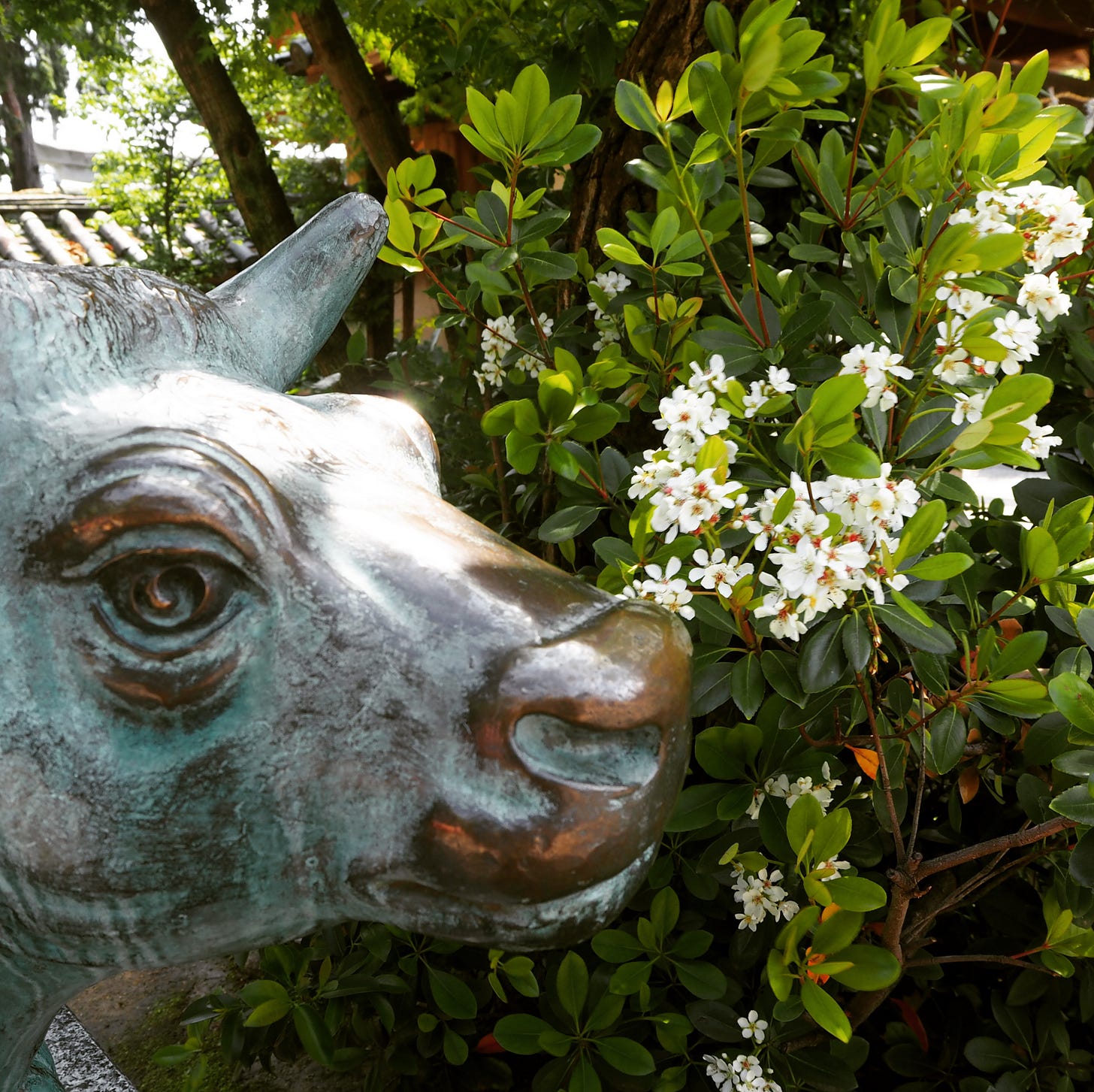There are moments in our lives when we feel the world around us—and perhaps within us—has fallen slightly out of tune.
In ancient Japan, people turned to Ōharae, the Great Purification, as a way to restore harmony not just with the divine, but with nature, community, and the self.
Ōharae no Kotoba, the sacred chant of this ritual, is not meant only for priests in grand shrines. It is a tool of self-purification:
a way to set things right through the power of words and the quiet strength of imagination.
In this post, I invite you to explore the world of Ōharae —
to walk between heaven and earth, to meet the kami who dwell in both,
and to rediscover a practice that helps us seek balance and renewal in our daily lives.
Shinto kami are not gods in the monotheistic sense. In Shinto, which many Japanese people practice not as a religion but as part of their way of life, this refers to a mindset that naturally finds the divine in all things around us—in the creatures, objects, and phenomena of the natural world.
Among them are kami who bring about defilement, and kami who carry it away. I invite you to read this as a long poem that expresses such a worldview.
This post introduces Ōharae as part of Japan’s cultural and poetic tradition. It is not meant to promote any religious belief or practice, but rather to share a view of how people have long sought harmony with nature and community through words and ritual.
Why do we chant ancient words?
The Ōharae no Kotoba(大祓詞)—the Great Purification Prayer recited during the Nagoshi no Ōharae—serves to cleanse ourselves of spiritual impurities and to return to a pure, bright state of mind and body, so that we may step into the next half of the year feeling refreshed. The divine beings who carry away these impurities are known as the Haraedo no Ōkami—the Four Great Kami of Purification (I call them ’the Haraedo Four’). These kami do not appear in the myths and legends, but they dwell quietly in the world around us, always near. When we recite the words of purification in ancient Japanese words, they take up our defilements as if passing a baton from one to the next, bearing them far, far away. Unlike norito (Shinto ritual prayers) that petition the kami for specific blessings, this is a prayer of self-purification. And so, wherever you may be—even far from Japan—you can speak these words and perform this act of cleansing as a cultural or meditative practice, should you wish to explore it.
(For more about what is impurity in Shinto, please see my post “What Happens Inside a Shinto Prayer Ritual”.)
How This Translation Is Presented
This time, I would like to share the full text of the Ōharae no Kotoba with you. It is a bit long, but I hope you will find it meaningful. That said, the Ōharae no Kotoba is written in ancient Japanese, in the special style of language used for norito (Shinto ritual prayers). So, first, I will provide an English translation that conveys the general meaning, so you can get an overall sense of it. After that, I will present the original text in hiragana (with numbered sections), followed by a romanized version and a more literal, section-by-section English rendering. Please note that the numbers are something I have added myself to make the text easier to follow—they are not official divisions. In fact, the Ōharae no Kotoba, like most norito, is traditionally written as one continuous flow without paragraph breaks.
The Great Purification Prayer: Oharae-no-kotoba
By the words of the two divine beings, male and female, who dwell in Takamanohara, the Plain of High Heaven—the imperial ancestors—
they summoned forth the myriad kami, and in solemn council, they pondered deeply.
Then they decreed that their beloved imperial grandchild should rule over Toyōashihara no Mizuho no Kuni,
that fair land of reed-fringed shores, as a realm of peace and harmony.
Thus, to the wild and defiant kami of that land, they sent word again and again,
but when no answer came, they were driven out, purified, and subdued.
Even the rocks, the stumps, the smallest blades of grass that refused the divine will
were made to fall silent and submit.
The seat of the imperial grandchild was released from the Takamonohara.
The manyfold clouds were parted with force, and down he came,
to the land of Mizuho no Kuni.
There, in the land entrusted by the ancestral kami,
at its very heart, they established Yamato,
a land of peace, a land of harmony.
The palace pillars were set deep upon bedrock;
the roof’s chigi soared so high as to touch the clouds.
Within this noble dwelling, shielded from rain, from dew, from the harsh sun,
the imperial grandchild took up his rule.
In that land of tranquil rule,
where new generations would arise,
many were the offenses, the failings, that might give rise to defilements—
amatsu tsumi, offenses against heaven;
kunitsu tsumi, earthly defilements, calamities born of this world.
When defilements arise thus, the ritual of heaven is followed.
The sacred wood is severed at base and tip;
the sacred sedge is cut, split fine and slender.
And the great norito of purification is proclaimed.
If thus one recites,
the Amatsu-kami will throw wide the Rock Door of Takamanohara,
part the manyfold clouds, and hear.
The Kunitsu-kami will climb to the peaks of the high and low mountains,
push aside the mists that rise, and listen.
When the kami have heard and accepted,
every defilement—each and every one—shall vanish without a trace.
As the wind of Shinado scatters the manyfold clouds,
as morning and evening winds clear away the gathered mists,
as a great ship is loosed from its moorings and set adrift upon the open sea,
as a keen sickle cuts away the roots of distant trees—
so shall the defilements be cleansed.
May the Amatsu-kami and Kunitsu-kami purify, cleanse, and leave not a single stain behind.
From the peaks of the high mountains,
in the swift rapids of rivers that boil and tumble,
Seoritsu-hime, who governs those sacred waters,
shall bear the defilements away to the great sea.
And there, where the tides meet and whirl,
Hayaakitsu-hime shall swallow them utterly.
Then Ibukido-nushi, at the Breath Door,
shall send them on the breeze to the Root Land, the Nether Land,
and at last Hayasasura-hime shall take them up,
bearing them away until no trace remains.
Thus, with all defilements cleansed, in every direction beneath the heavens,
from this day forth, no defilement shall remain.
Let it be known, let it be accepted
by the Amatsu-kami, the Kunitsu-kami, and all the myriad kami together:
all defilements, every last one, have been swept away.
the original text in hiragana (with numbered sections)
1 たかまのはらに かむずまります すめらがむつ かむろぎ かむろみのみこともちて
2 やおよろずのかみたちを かむつどへにつどへたまひ かむはかりにはかりたまいて
3 あがすめみまのみことは とよあしはらのみずほのくにを やすくにとたいらけくしろしめせと ことよさしまつりき
4 かくよさしまつりし くぬちにあらぶるかみたちをば かむとはしにとはしたまひ かむはらいにはらひたまひて
5 こととひしいわね きねたち くさのかきはをもことやめて
6 あめのいわくらはなち あめのやえぐもを いずのちわきにちわきて あまくだしよさしまつりき
7 かくよさしまつりし よものくになかと おおやまと ひだかみのくにをやすくにとさだめまつりて
8 したついわねに みやばしら ふとしきたて たかまのはらに ちぎたかしりて
9 すめみまのみことの みずのみあらか つかへまつりて あめのみかげ ひのみかげとかくりまして
10 やすくにとたいらけくしろしめさむ くぬちになりいでむ あめのますひとらが
11 あやまちおかしけむ くさぐさのつみごとは あまつつみ くにつつみ ここだくのつみいでむ
12 かくいでば あまつみやごともちて
13 あまつかなぎをもとうちきり すえうちたちて ちくらのおきくらにおきたらはして
14 あまつすがそを もとかりたち すえかりきりて やはりにとりさきて
15 あまつのりとの ふとのりとごとをのれ
16 かくのらば あまつかみはあめのいわとをおしひらきて あめのやえぐもを いずのちわきにちわきて きこしめさむ
17 くにつかみは たかやまのすえ ひきやまのすえにのぼりまして たかやまのいほりひきやまのいほりを かきわけて きこしめさむ
18 かくきこしめしてば つみというつみはあらじと しなどのかぜのあめのやえぐもをふきはなつことのごとく
19 あしたのみぎり ゆうべのみぎりを あさかぜゆうかぜのふきはらふことのごとく
20 おおつべにおるおおふねを へときはなち ともときはなちて おおうなばらにおしはなつことのごとく
21 おちかたのしげきがもとを やきがまのとがまもちて うちはらふことのごとく
22 のこるつみはあらじと はらへたまひきよめたまふことを
23 たかやまのすえ ひきやまのすえより さくなだりにおちたぎつ はやかわのせにます せおりつひめといふかみ おおうなばらにもちいでなむ
24 かくもちいでいなば あらしおのしおのやおじのやしおじのしおのやおあいにますはやあきつひめといふかみ もちかかのみてむ
25 かくかかのみてば いぶきどにますいぶきどぬしといふかみ ねのくにそこのくににいぶきはなちてむ
26 かくいぶきはなちてば ねのくにそこのくににます はやさすらひめといふかみ もちさすらいうしないてむ
27 かくさすらひうしなひてば つみといふつみはあらじと はらへたまひきよめたまふことを
28 あまつかみ くにつかみ やおよろずのかみたちともに きこしめせともうす
A romanized version
1 takama no hara ni kamuzumarimasu sumeragamutsu kamurogi kamuro mi no mikoto mochite
2 yaoyorozu no kami-tachi o kamutsudoe ni tsudoe tamai kamu hakari ni hakari tamai te
3 aga sumemima no mikoto wa toyoashihara no mizuho no kuni o yasukuni to tairakeku shiroshi mese to kotoyosasimatsuriki
4 kaku yosasimatsurishi kunuchi ni araburu kami-tachi oba kamu towashi ni towashi tamai kamu harai ni harai tamai te
5 kototoishi iwane kinetachi kusa no kakiha o mo kotoyamete
6 ame no iwakura hanachi ame no yaegumo o izuno chi waki ni chi waki te amekudashi yosasimatsuriki
7 kaku yosasimatsurishi yomo no kuni naka to ooyamato hidakami no kuni o yasukuni to sadame matsuri te
8 shitatsu iwane ni miyabashira futoshiki tate takama no hara ni chigi takashiri te
9 sumemima no mikoto no mizu no mi araka tsukae matsuri te ame no mikage hi no mikage to kakurimashi te
10 yasukuni to tairakeku shi roshi mesamu kunuchi ni nari idemu ame no masu hito ra ga
11 ayamachi okashikemu kusagusa no tsumigoto wa amatsu tsumi kunitsu tsumi kokodaku no tsumi idemu
12 kaku ideba amatsu miyagoto mochite
13 amatsu kanagi o moto uchikiri sue uchitati te chikura no okikura ni okitarawashite
14 amatsu sugasowo moto kari tachi sue kari kirite yahari ni tori sakite
15 amatsu norito no futonoritogoto o nore
16 kaku noraba amatsu kami wa ame no iwato o oshi hiraki te ame no yaegumo o izuno chi waki ni chi waki te kikoshimesamu
17 kunitsu kami wa takayama no sue hikiyama no sue ni nobori mashite takayama no iori hikiyama no iori o kaki wakete kikoshimesamu
18 kaku kikoshimeshiteba tsumi to iu tsumi wa araji to shinado no kaze no ame no yaegumo o fuki hanatsu koto no gotoku
19 ashita no migiri yuube no migiri o asa kaze yuu kaze no fuki harau koto no gotoku
20 ootsube ni oru oofune o he toki hanachi tomo toki hanachi te oounabara ni oshi hanatsu koto no gotoku
21 ochikata no shigeki ga moto o yaki gama no togama mochi te uchi harau koto no gotoku
22 nokoru tsumi wa araji to harae tamai kiyome tamau koto o
23 takayama no sue hikiyama no sue yori sakunadari ni ochitagitsu hayakawa no se ni masu seoritsu hime to iu kami oounabara ni mochi ide namu
24 kaku mochi ide inaba arashio no shio no yaoji no yashioji no shio no yaoai ni masu hayaakitsu hime to iu kami mochi kakanomitemu
25 kaku kakanomiteba ibukido ni masu ibukido nushi to iu kami ne no kuni soko no kuni ni ibuki hanachi te mu
26 kaku ibuki hanachi te ba ne no kuni soko no kuni ni masu hayasasura hime to iu kami mochi sasurai ushinai te mu
27 kaku sasurai ushinai te ba tsumi to iu tsumi wa araji to
28 amatsu kami kunitsu kami yaoyorozu no kami-tachi tomo ni kikoshimese to mousu
A section-by-section English rendering
1 By the words of the two divine beings, male and female, who reside in Takamanohara (the Plain of High Heaven), the imperial ancestors...
2 Having gathered many kami (deities), and after fully carrying out deliberations...
3 Then they decreed that their beloved imperial grandson should govern the land of Toyōashihara no Mizuho no Kuni (a poetic name for our country, given from the image of vast reed plains along the coast, where the ears of reeds waved richly and beautifully) as a peaceful and tranquil realm.
4 Thus, to the raging and violent kami dwelling in the land entrusted to him, they repeatedly inquired why they would not submit. And when they still did not respond, they were thoroughly driven away.
5 Even the rocks, stumps of trees, and the smallest blades of grass that defied the words and would not submit were made to quiet their clamor.
6 They released the divine seat where the imperial grandchild resided from Takamanohara, and, parting and pushing aside with fierce force yaegumo八重雲(the many-layered clouds), they brought him down to the land of Mizuho no Kuni.
7 Thus, in the land entrusted by the ancestral kami to govern, at its center, they determined Yamato no Kuni大和の国 to be a peaceful and tranquil country.
8 Setting the palace pillars stoutly so deep that they reach the solid bedrock beneath the earth, and raising the roof’s chigi (decorative forked finials characteristic of Shinto architecture) so high that they are heard by the clouds...
9 Having humbly built the noble palace of the imperial grandchild, making it a palace that shelters from the rain and dew and covers against the strong sunlight, he dwells therein...
10 In this land that he governs in peace, the people who will newly be born...
11 The various offenses and transgressions they may commit will give rise to many defilements: amatsu tsumi天つ罪 (heavenly defilements — offenses of disrespect toward the kami) and kunitsu tsumi 国つ罪(earthly defilements — impurities and calamities likely to occur in the real world)...
12 If thus many defilements arise, following the ritual of the amatsu kami (heavenly gods) in Takamanohara,
13 The heavenly sacred wood (hard wooden pieces) is cut at its base, severed at its tip, and many sacred tables are filled by placing them upon them.
14 The heavenly sedge hemp is cut off at its base, its tip is cut and discarded, the middle part is taken, and with a needle it is finely split into many thin strands.
15 Recite the purification norito bestowed by the heavenly kami.
16 If one recites thus, the Amatsu-kami will push open the Rock Door of Takamanohara and, forcefully parting the manyfold heavenly clouds, will surely listen.
17 The Kunitsu-kami will ascend to the peaks of the high mountains and the summits of the low mountains, parting the rising mists from the tall and short mountains, and will surely listen to the great norito.
18 Thus, if the Amatsu-kami and Kunitsu-kami have listened and accepted, all defilements—every last one—will vanish without a trace. It will be as if the wind of Shinado blows forth, scattering the manyfold heavenly clouds.
19 Just as the morning and evening winds blow away the mists that gather at dawn and dusk.
20 Just as a great ship moored at a large port is released by loosening its ropes and is sent forth into the vast ocean.
21 Just as the thick roots of distant trees are cut away and cleared with a keen, well-tempered sickle.
22 That the Amatsu-kami and Kunitsu-kami may purify and cleanse so that not a single defilement is left behind.
23 From the peaks of the high mountains and the low mountains, in the rapids of the swift river that falls and boils as a mountain stream, the kami called Seoritsu-hime, who governs that place, will carry away the defilements by her divine power to the great expanse of the sea.
24 Thus, once the defilements have been carried out to the great expanse of the sea, the kami called Haya-akitsu-hime, who dwells where the many tides meet and swirl in whirlpools, will swallow up the defilements completely.
25 Thus, the defilements that have been swallowed will next be blown away to the Root Land and the Nether Land by the kami called Ibukido-nushi, who resides at the Breath Door. (Ibuki means breath, referring to a gentle breeze; Ibukido-nushi is the kami who governs the soft winds.)
26 Thus, the defilements that have been swept away will at last be received by the kami called Hayasasura-hime, who dwells in the Root Land and the Nether Land, and she will bear them away so that their whereabouts are no longer known.
27 Thus, when all defilements have been completely removed, in all directions under heaven, from this day onward, there shall be no defilement remaining.
28 Let it be heard and accepted by the Amatsu-kami, the Kunitsu-kami, and all the myriad kami together: that all defilements—every last one—have been wiped away.
If you’ve made it this far, well done!
Here’s a relaxing image of a cat taking a nap to soothe your soul.
*A note from Toukyo
The names in bold are the Haraedo no Okami (Purification Deities).
Seoritsu-hime(せおりつひめ)
Haya-Akitsu-hime(はやあきつひめ)
Ibukido-nushi(いぶきどぬし)
Haya-Sasura-hime(はやさすらひめ)
I like to call them ”The Haraedo Four”—because they’re a team that brilliantly and boldly carries impurities away.
Those whose names end with hime are female deities.
So, three of the four are female kami.
(Why this is so, I do not know—but I like to think it’s because women are braver!)
Amatsu-kami and Kunitsu-kami:
Amatsu-kami
The Amatsu-kami are the celestial kami, deities who govern from the realm of heaven. They are associated with cosmic order, harmony, and the divine mandate that establishes peace in the human world.
Examples include:
Amaterasu Ōmikami (天照大神): the sun goddess, central to the imperial lineage.
Takami-musubi no Kami (高御産巣日神): a creator deity, source of life and destiny.
Kamimusubi no Kami (神産巣日神): another deity linked with creation and growth.
Kunitsu-kami
The Kunitsu-kami are the kami of the land itself. They represent the ancient, untamed forces of nature that inhabited the Japanese archipelago long before the heavenly kami descended. They are guardians and embodiments of place, of river and mountain, of field and forest.
Examples include:
Ōkuninushi no Kami (大国主神): lord of the land and its hidden mysteries.
Sarutahiko no Kami (猿田彦神): a guide between the heavenly and earthly realms.
Susanoo: The kami Who Crosses Worlds
Susanoo-no-Mikoto (須佐之男命) is unique among the kami. Though born as an Amatsu-kami, he is deeply tied to the earthly world, and his stories tell of his descent, conflict, and eventual reconciliation with the land and its deities.
He is the storm kami, wild and unpredictable—both a force of destruction and renewal.
His actions bridge the heavenly and earthly realms, sometimes in defiance, sometimes in service of harmony.
In the Ōharae no Kotoba, we can sense echoes of this duality: the need to restore balance when cosmic and terrestrial forces fall out of accord.
Susanoo’s journey reflects the broader Shinto view that the boundary between heaven and earth is not absolute. The sacred moves between realms, and purification reconnects what has drifted apart.
The Wish Carried by Purification
This post is meant as a cultural and historical exploration of Ōharae and its language of purification. It is not intended to promote any religious practice or belief.
When we recite the Ōharae no Kotoba, we are offering a simple, heartfelt wish — not as a religious act, but as a reflection of a cultural desire for harmony...
that what has become divided may come together again,
and that natural disasters and illness may not grow too severe—
so that we may live our days in peace and quiet balance.
I hope this exploration has offered you a glimpse into how the Japanese people have long sought harmony with nature and community through words, ritual, and imagination — not as a matter of faith, but as a way of living in tune with the world.
Thank you so much for taking the time to read this long post! If you’d like to learn about other important elements of the Great Purification Ceremony, such as katashiro and the chinowa ring, please take a look at my previous post, Get Ready For Summer!. I’m also planning a Q&A Matsuri (festival) soon, so please feel free to share your thoughts and questions in the comments section. I look forward to seeing you again next Tuesday!













(Why this is so, I do not know—but I like to think it’s because women are braver!)
I like that idea.
The scurrilous part wonders whether the real reason is because women are usually the ones who have to clean up after the party.... because I can picture three obasans and one ojisan sweeping everything up, setting the tables straight, washing the dishes and so on.
I have read many translations of the Ōharae no Kotoba, and I have to say yours is now one of my favorites, your writing is very poetic and perfect for the translation of older styles!
Thank you for providing such a wonderful breakdown, I will now be recommending this to new Shinto followers as a great intro to the prayer!!
And I remember how surprised I was to find a shrine in (I think?) Uji dedicated to Seoritsuhime no Kami And Hayaakitsuhime no Kami! Albeit I think that was linked to The Tale of Genji, and the fact that it was near the Uji River. Regardless it was neat seeing their names written down as the Gosaijin.
Looking forward to your next article!